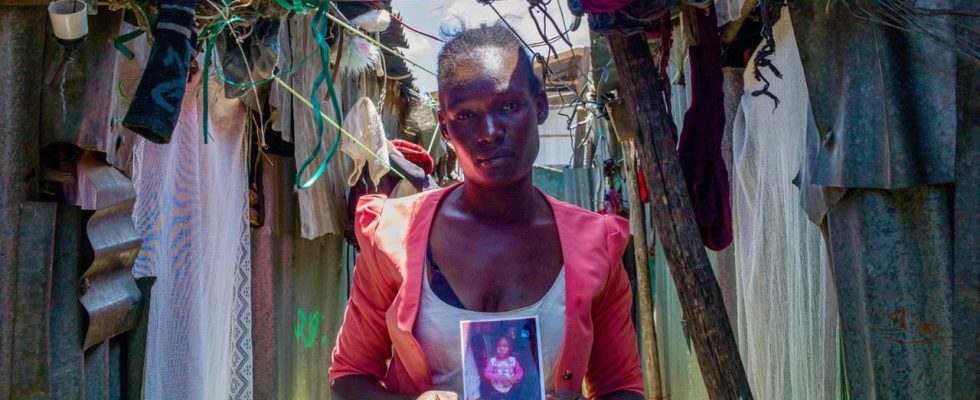Thousands of children disappear in Kenya every year. A pattern emerges: the children are kidnapped and sold. An NGO that has reunited almost 1,100 missing children with their families is providing hope.
In the Mukuru slums on the edge of Nairobi’s industrial area, hundreds of thousands live in the most adverse conditions. It’s hard to make ends meet here. Some are lucky and run a small business selling everything on the side of the road: shoes, chickens, tools.
The fact that children regularly disappear is a big issue here. Everyone here knows that children go missing, says Miriam Josiah, who sells coal briquettes on the side of the road: “Modestar’s child, who was just lost, has been gone for three months now and hasn’t been found yet. Another child, a girl, is just recently disappeared around the corner; she hasn’t been found either. We’re all very worried.”
In constant fear
Fashion star Lumbasi lives around the corner in a corrugated iron hut. You have to duck your head when you want to visit them so as not to cut yourself on the sharp edges of the protruding sheet metal. Just a few months ago, her three-year-old son Peter also played here.
But in mid-December he disappeared without a trace, says the 30-year-old – right in front of her hut. Since then, Lumbasi has lived in constant fear for her other child, a six-month-old girl. She usually wears it in a wrap, tied tightly to her body. She says she “can’t leave it alone for even a second,” no matter where she goes. Even if she goes to the toilet, she has to take the child with her – or lock her in the house.
In Nairobi’s Mukuru slum, the traders know many stories of missing children.
The consequences of loss
Fashion star Lumbasi says she is not giving up hope despite being in a precarious situation. She says she used to sell shoes on the side of the road. But since her child is gone, she simply can’t work anymore. Her husband therefore reproaches her for apparently having a lot of money and therefore not looking for work. Sometimes he just walks away without leaving her something to eat.
Peter Lumbasi is one of thousands of children and young people who disappear in Kenya every year. There are no official, publicly available statistics on this. Also the inquiries from ARD from the state authorities remain unanswered. However, in an interview in May 2023, a Kenyan minister mentioned that 6,841 missing person cases were reported in the period from July 2022 to May 2023 alone. Of these, only about 1,300 children returned home.
This corresponds to a clearance rate of 19 percent. For comparison: Thousands of children and young people disappear every year in Germany, but according to the BKA, around 97 percent of them are found again.
Fashion star Lumbasi is desperately waiting for a sign of life from her missing son Peter.
The perpetrators are becoming more cautious
In 2020, Kenyan journalist Njeri Mwangi revealed for the BBC that children are being kidnapped on a large scale and sold to childless families. The research sparked a wave of indignation, and one perpetrator was sentenced to 25 years in prison. But not much else happened, and Mwangi suspects that the baby thieves have now become much more careful. There is a whole network of perpetrators – you don’t know who is stealing the children and where they are going.
Mwangi complains that society in Kenya has changed for the worse. For a long time, the entire community cared about children, not just the parents. According to the motto: It takes a whole village to raise a child.
But today people are more busy with their own affairs. So a lot has to change, not only among the authorities but also in society as a whole, says the 43-year-old.
Njeri Mwangi fears that child thieves will continue to operate systematically – just more carefully.
An organization is looking
The affected families, on the other hand, accuse the police of reacting too slowly and showing little interest when it comes to children from poor families. This is where Maryana Munyendo comes into play. She runs the donation-funded organization Missing Child Kenya and helps desperate parents.
With five employees, she ensures that the children are searched for as quickly as possible, especially via the Internet. Munyendo describes Missing Child Kenya as a community-driven organization. Ultimately, she is dependent on her search reports being disseminated. She tries to make it clear to people “that they are also our eyes and ears in the field.”
Missing Child Kenya has worked on 1,548 missing person cases in the past eight years. Almost 1,100 of these missing children have been reunited with their families. On average, the organization is currently accepting one new case every day. To this day, Missing Child Kenya has not been able to find little Peter Lumbasi.
Liberation gives hope
But this week the police in Nairobi achieved a rare manhunt and Peter’s mother Modestar got a small glimmer of hope. After a tip-off, the police rescued children from a house on the outskirts of the city. Initially it was said that 16 children had been freed. After ARDAccording to information, the number is likely to be significantly higher. A Kenyan woman and a man from Tanzania were arrested. The police believe they belong to a human trafficking ring.
Is Peter among the children found? Modestar and other parents immediately rush to the relevant police station. But no one there can tell her how long it will take until the children found are identified: “They said I have to wait. I’m not mad. I’ll wait. They’re just doing their job.”
Collaboration: Anne Fleischmann and Patrick Gatua
Srdjan Govedarica, ARD Nairobi, tagesschau, February 23, 2024 5:34 p.m

